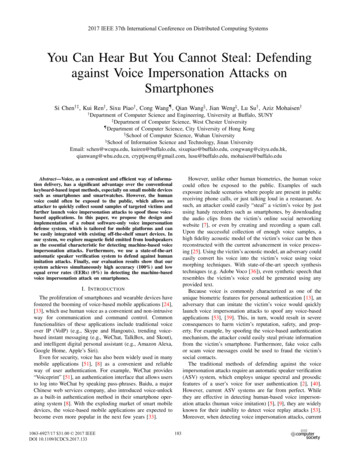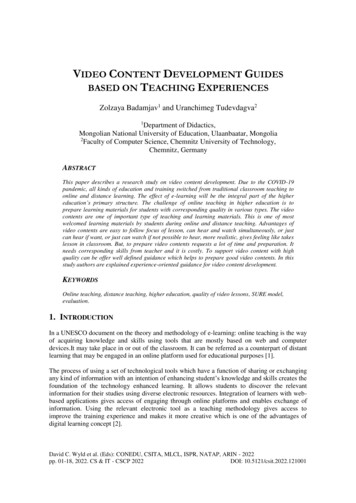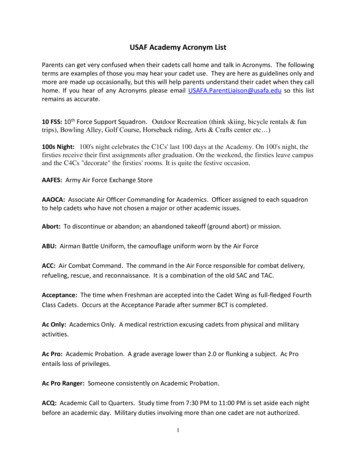
Transcription
2017 IEEE 37th International Conference on Distributed Computing SystemsYou Can Hear But You Cannot Steal: Defendingagainst Voice Impersonation Attacks onSmartphonesSi Chen†‡ , Kui Ren† , Sixu Piao† , Cong Wang¶ , Qian Wang§ , Jian Weng , Lu Su† , Aziz Mohaisen††Department of Computer Science and Engineering, University at Buffalo, SUNY‡Department of Computer Science, West Chester University¶Department of Computer Science, City University of Hong Kong§School of Computer Science, Wuhan University School of Information Science and Technology, Jinan UniversityEmail: schen@wcupa.edu, kuiren@buffalo.edu, sixupiao@buffalo.edu, congwang@cityu.edu.hk,qianwang@whu.edu.cn, cryptjweng@gmail.com, lusu@buffalo.edu, mohaisen@buffalo.eduAbstract—Voice, as a convenient and efficient way of information delivery, has a significant advantage over the conventionalkeyboard-based input methods, especially on small mobile devicessuch as smartphones and smartwatches. However, the humanvoice could often be exposed to the public, which allows anattacker to quickly collect sound samples of targeted victims andfurther launch voice impersonation attacks to spoof those voicebased applications. In this paper, we propose the design andimplementation of a robust software-only voice impersonationdefense system, which is tailored for mobile platforms and canbe easily integrated with existing off-the-shelf smart devices. Inour system, we explore magnetic field emitted from loudspeakersas the essential characteristic for detecting machine-based voiceimpersonation attacks. Furthermore, we use a state-of-the-artautomatic speaker verification system to defend against humanimitation attacks. Finally, our evaluation results show that oursystem achieves simultaneously high accuracy (100%) and lowequal error rates (EERs) (0%) in detecting the machine-basedvoice impersonation attack on smartphones.However, unlike other human biometrics, the human voicecould often be exposed to the public. Examples of suchexposure include scenarios where people are present in publicreceiving phone calls, or just talking loud in a restaurant. Assuch, an attacker could easily “steal” a victim’s voice by justusing handy recorders such as smartphones, by downloadingthe audio clips from the victim’s online social networkingwebsite [7], or even by creating and recording a spam call.Upon the successful collection of enough voice samples, ahigh fidelity acoustic model of the victim’s voice can be thenreconstructed with the current advancement in voice processing [25]. Using the victim’s acoustic model, an adversary couldeasily convert his voice into the victim’s voice using voicemorphing techniques. With state-of-the-art speech synthesistechniques (e.g. Adobe Voco [36]), even synthetic speech thatresembles the victim’s voice could be generated using anyprovided text.Because voice is commonly characterized as one of theunique biometric features for personal authentication [13], anadversary that can imitate the victim’s voice would quicklylaunch voice impersonation attacks to spoof any voice-basedapplications [53], [39]. This, in turn, would result in severeconsequences to harm victim’s reputation, safety, and property. For example, by spoofing the voice-based authenticationmechanism, the attacker could easily steal private informationfrom the victim’s smartphone. Furthermore, fake voice callsor scam voice messages could be used to fraud the victim’ssocial contacts.The traditional methods of defending against the voiceimpersonation attacks require an automatic speaker verification(ASV) system, which employs unique spectral and prosodicfeatures of a user’s voice for user authentication [2], [40].However, current ASV systems are far from perfect. Whilethey are effective in detecting human-based voice impersonation attacks (human voice imitation) [5], [9], they are widelyknown for their inability to detect voice replay attacks [53].Moreover, when detecting voice impersonation attacks, currentI. I NTRODUCTIONThe proliferation of smartphones and wearable devices havefostered the booming of voice-based mobile applications [24],[33], which use human voice as a convenient and non-intrusiveway for communication and command control. Commonfunctionalities of these applications include traditional voiceover IP (VoIP) (e.g., Skype and Hangouts), trending voicebased instant messaging (e.g., WeChat, TalkBox, and Skout),and intelligent digital personal assistant (e.g., Amazon Alexa,Google Home, Apple’s Siri).Even for security, voice has also been widely used in manymobile applications [51], [8] as a convenient and reliableway of user authentication. For example, WeChat provides“Voiceprint” [51], an authentication interface that allows usersto log into WeChat by speaking pass-phrases. Baidu, a majorChinese web services company, also introduced voice-unlockas a built-in authentication method in their smartphone operating system [8]. With the exploding market of smart mobiledevices, the voice-based mobile applications are expected tobecome even more popular in the next few years [33].1063-6927/17 31.00 2017 IEEEDOI 10.1109/ICDCS.2017.133416183
ASV systems require a prior knowledge of specific voiceimpersonation techniques used by the attacker [29]. Such anassumption does not necessarily always hold in practice. Forexample, one recent work [54] has demonestrated that ASValone could be subject to sophisticated machine-based voiceattacks. Hence, more robust designs resilient to both humanbased and machine-based voice impersonation attacks are ingreat demand yet to be fully explored.To build a robust defense system, there are many challenging barriers to overcome. One of the critical challengesis to defend against both human-based and machine-basedattacks simultaneously. To achieve this goal, we leveragethe following insights: in machine-based voice impersonationattacks (such as the replay attack, voice morphing attack, andvoice synthesize attack), an attacker usually needs to use aloudspeaker (e.g., PC loudspeaker, smartphone loudspeaker,and earphone) to transform the digital or analog signal intothe sound. The conventional loudspeaker uses magnetic forceto broadcast the sound and leads to the generation of amagnetic field. Thus, if we can capture this magnetic field bymonitoring the magnetometer reading from the smartphone,we can leverage it as a key differentiating factor between ahuman speaker and a loudspeaker. By carefully integratingour detection method with the current AVS systems, we canachieve a much more robust design to defend against all typesof voice impersonation attacks on smartphones.In addition to defending against attacks launched via conventional loudspeakers, we also consider special cases ofmachine-based voice impersonation attacks launched via smallearphones. In such scenarios, the magnetic force emitted canbe too small to be sensed directly by the magnetometer. Toaddress this challenge, we resort to detecting the channelsize of the sound source, and design a sound field validationmechanism to ensure that the sound source size is alwaysclose to a human mouth (i.e., not an earphone). By crosschecking both approaches, together with the careful integrationof an existing AVS system, we can defeat the vast majority ofvoice impersonation attacks and significantly raise the level ofsecurity for existing voice-based mobile applications.Contribution. Our main contributions are as follows:1) We propose a robust software-only defense system againstvoice impersonation attacks, which is tailored for mobile platforms and can be easily integrated with off-the-shelf mobilephones and systems.2) We use advanced acoustic signal processing, mobile sensing, and machine learning techniques, and integrate them as awhole system to efficiently detect voice impersonation attacks.3) We build our system prototype and conduct comprehensiveevaluations. The experimental results show that our system isrobust and achieves very high accuracy with zero equal errorrates (EER) in defending against voice impersonation.Organization. In the rest of the paper, we begin with thebackground and related work in Section II, followed by theproblem formulation in Section III. Section IV describesthe scheme overview and design details. The implementationdetails are presented in Section V. The evaluation results arein Section VI. We further discuss our solution in Section VII.Finally, Section VIII concludes this paper.II. BACKGROUND AND R ELATED W ORKVoice-based Mobile Applications. Based on their functionality, existing voice-based mobile applications can be dividedinto two categories: i) voice communication ii) voice control.For voice communication, there are VoIP apps and instantvoice message apps. As previously stated, by imitating avictim’s voice, tone and speaking style, the attacker couldeasily launch impersonation attacks that would lead to severeharm to the victim. On the other hand, the applications inthe second category allow users to use their voice commandsto control the smartphone, using services such as the voicerecognition and assistant and voice authentication. For voicerecognition and assistant, Siri and Google Voice Search (GVS)are two noteworthy representative systems on iOS and Androidsystems, respectively.In [14], the authors presented a recent threat that uses GVSapplication to launch voice-based permission bypassing attackand steal private user information from smartphones. As forvoice authentication, quite a few mobile apps have adoptedit as a built-in method for user authentication and systemlogin. Besides the aforementioned WeChat “Voiceprint” [51]interface, Superlock [20] is another example that utilizesuser’s voice to lock and unlocks the phone. Unfortunately, arecent study shows that these authentication systems could bespoofed by an attacker mimicking the voice of the victim [53].Automatic Speaker Verification (ASV) System. An ASVsystem can accept or reject a speech sample submitted by auser, and verify her as either a genuine speaker or an imposter[43], [27]. It can be text-dependent (with required utterancesfrom speakers) or text-independent (able to accept arbitraryutterances) [10]. Text-independent ASV systems are more flexible and are able to accept arbitrary utterances, i.e., differentlanguages, from speakers [10]. The text-dependent ASV ismore widely selected for authentication applications, sinceit provides higher recognition accuracy with fewer requiredutterances for verification. The current practice for buildingan ASV system involves two processes: offline training andruntime verification. During the offline training, the ASVsystem uses speech samples provided by the genuine speakerto extract certain spectral, prosodic (see [2] and [40]) or otherhigh-level features (c.f. [15] and [35]), to create a speakermodel. Later in the runtime verification phase, the incomingvoice is verified against the trained speaker model.As shown in Fig. 1, a generic ASV system contains sevenvulnerability points. Attacks at point (1) are the voice impersonation attacks, where the attacker tries to impersonateanother person by using pre-recorded or synthesized voicesample before transmitting them into the microphone [23].Attacks at point (2-6) are the indirection attacks [32], whichare performed within the ASV system. In our paper, we buildour defense system focusing on the first type of the attacks.184417
Fig. 1: A generic automatic speaker verification (ASV) system with seven possible attack points. The attack at point 1 denotesthe voice impersonation attacks, whereas the attack at points 2 through 6 denote the indirection attacks.Voice Impersonation Attack. The voice impersonation attackimplies an attack targeting the ASV system using a prerecorded, manipulated or synthesized voice samples to deceivethe system into verifying a claimed identity [29]. The work in[26] suggests that, even though professional human impersonators are more effective than the untrained, they are still unableto repeatedly fool an ASV system. To address the human-basedvoice impersonation attacks, the work in [5], [9] proposed adisguise detection scheme. The scheme exploits the fact thatvoice samples submitted by an impersonator are less practicedand exhibit larger acoustic parameter variations. In particular,[5] claims a 95.8% to 100% detection rate for human-basedimpersonation attacks.loudspeakers. We then use this physical characteristic of theconventional loudspeakers to detect machine-based impersonator on smartphones, instead of analyzing the acoustic featuresof speech samples.III. P ROBLEM F ORMULATIONA. Adversary ModelThe voice impersonation attack aims at attacking biometricidentifiers of a system. In our adversary model, an attacker isable to collect the voice samples of the victim. As mentionedpreviously, this can be achieved by the attacker with littlecost, since human voice could often be exposed to the public.Once an attacker acquires the voice samples, the attacker isable to use different methods to change their voice biometricsto appear like the victim. Then, the attacker can performspoofed phone calls, or launch replay attacks, voice conversionattacks and voice synthesis attacks, through voice messagingand voice authentication applications. Based on the methodsthe attacker uses, we divide the voice impersonation attacksinto the following two categories:1) Machine-based Voice Impersonation Attack. In thistype of attack, the attacker has the ability to leverage computerand other peripherals (e.g., loudspeaker) to gain the capabilityof voice replaying or voice morphing. Therefore, the attackercan imitate the target’s voice at a high degree of similarity. Weassume the attacker has a permanent or temporary access to themobile application’s front-end, which displays the voice-basedI/O interface (e.g., a victim’s mobile phone). Based on thecapability of the attacker, we can further divide the machinebased voice impersonation attacks into three types.Type 1: Voice Replay Attack. In this type of attack, theattacker is able to acquire an audio recording of the target’svoice prior to the attack. The attacker tries to spoof the speakerverification system by replaying the voice sample using aloudspeaker.Type 2: Voice Morphing Attack. In this type of attack,the attacker is able to imitate the target’s voice by applyingvoice morphing (conversion) techniques. We assume that thevoice spoofing techniques used by the attacker can producehigh-quality output with all details of the human vocal tract.Moreover, the attacker has the ability to simulate the excitationAnother method of voice impersonation is the machinebased voice impersonation attack, such as replay attack,voice synthesis or conversion attack. To launch this type ofattack, the attacker needs to seek help with specific devices(e.g., microphone, computer and loudspeaker). In [46], theauthor shows that an attacker can concatenate speech samplesfrom multiple short voice segments of the target speaker andovercome text-dependent ASV systems by launching replayattacks. Although a few system research papers on developingreplay attack countermeasures have been published [30], [38],[46], [47], [50], all these systems suffer from high falseacceptance rate (FAR) compared to the respective baselines. In[4], the authors demonstrate vulnerabilities of ASV systems forvoice synthesis attacks with artificial speech generated fromtext input. The work in [42], [55] propose the voice conversionattack in which the attacker converts the spectral and prosodyfeatures of her own speech in resembling the victim’s. To detect voice synthesis and voice conversion attack, [56] exploitedartifacts introduced by the vocoder to discriminate convertedspeech from original speech. A more recent work [3] claims amethod that can detect voice conversion attack effectively byestimating dynamic speech variability.The essential difference between our work and previousstudies lies in the method we use for machine-based voiceimpersonation detection. We design a more general countermeasure by leveraging smartphone-equipped magnetometerto detect the magnetic field produced by the conventional185418
Fig. 2: The architecture of conventional loudspeaker showingthe magnet, coil and cone used for loudspeaker operations.Fig. 3: A typical use case of our system.based voice impersonation attacks has been proven ineffective.Thus, we address this problem from a new perspective.We note that different from human-based voice impersonation, the machine-based impersonation attack requires theattacker to convert the digital signal to an audible sound by theassistance of a loudspeaker. Moreover, most of today’s conventional (dynamic) loudspeakers contain a permanent magnet,a metal coil behaving like an electromagnet, and a cone totranslate an electrical signal into an audible sound [34], asshown in Fig. 2. When operating correctly, such a loudspeakerwould naturally produce a magnetic field, originating fromboth the permanent magnet fixed inside the speaker, and themovable coil that creates a dynamic magnetic field when anelectric current flows through it.Therefore, our key insight is to detect the magnetic field produced by the conventional loudspeakers. By using the magnetometer (compass) in modern smartphones, we can distinguishbetween a human speaker and a computer loudspeaker, sincethe human vocal tract would not produce any magnetic field.As we show below, such observations will help us design andobtain a robust defense system with high accuracy. Moreover,we use the Spear speaker verification system as a buildingblock to defend against the human impostor.of the vocal tract naturally. The attacker tries to spoof thespeaker verification system by broadcasting the morphed voiceusing a loudspeaker to impersonate the targeted legitimateuser.Type 3: Voice Synthesize Attack. This type of attacker isable to synthesize target voice by using the state-of-the-artspeech synthesizers techniques. We assume the attacker is ableto use text-to-speech (TTS) technique to generate the naturalsounding synthetic speech of the targeted user from any inputtexts. The attacker tries to spoof the speaker verificationsystem by directly broadcasting the synthetic voice using aloudspeaker.We note that in the last step of each of the three typesof attacks, a loudspeaker (e.g., PC loudspeaker, smartphoneloudspeaker, etc.) is required to broadcast the processed voice.Thus, if the differentiation between the voice produced by ahuman and by a loudspeaker is clear, we can defend against themachine-based voice impersonation attacks from the sourcevalidation. The key insight of our design is discussed in thefollowing section.2) Human-based Voice Impersonation Attack. This typeof attack, the attacker utilizes the acquired voice sample toimitate the target’s voice without the help of any computeror professional devices. In particular, the attacker may use hisvoice or could seek help from other people (e.g., someone whocan imitate the target’s voice very closely). To defend againstthis type of attack, we utilize the state-of-the-art ASV systemwhich leverages the acoustic features from the voice samplesto perform voice impersonation attack detection.C. Use CasesTo successfully leverage our key insight, we require users toplace the smartphone as close as possible to the sound source.This is because the magnetic field produced by the loudspeakercan only be detected within a short range. However, thedistance between the smartphone and the sound source ishard to measure. Therefore, we design non-intrusive use casesto confine the moving pattern of the smartphone and assistin measuring the distance. As shown in Fig. 3, our schemerequires the user first to open our mobile application andhold the smartphone near his head vertically or horizontally(a similar interaction model has been adopted by [11]); theuser starts speaking the voice command while moving thesmartphone towards his or her mouth at the same time. Finally,the user waits for our application to verify his identity. Duringthis process, our application first collects the acoustic data andthe reading of the inertial sensors, and then feeds them intothe verification pipeline.B. Key InsightsOur key goal is to differentiate genuine speakers from bothmachine-based and human-based impostors on smartphones.For human-based impostor, there already exist sophisticatedspeaker verification systems, such as the open-sourced BobSpear verification toolbox developed by Khoury et al. [21],which has been recognized for its performance in detectingagainst human-based impersonation attacks [53], [5], [9].For the machine-based impersonation attack, the existingstate-of-the-art voice authentication systems can be easily circumvented by voice replay and conversion tools (e.g., Festvox[16]), among others. Therefore, relying on the spectral andprosodic features within the voice to defend against machine-186419
! ! ! " ! # ! Fig. 4: The architecture of our defense system. Fig. 6: Received spectrograph of the high-frequency tone whilemoving the phone.Fig. 5: Geometric constraint of our systemIV. T HE P ROPOSED S OLUTIONmotion trajectory data, we are able to verify if the sound isproduced by a human speaker or a loudspeaker. The fourthcomponent is designed for speaker identity verification, andis based on analyzing the spectral and prosodic features ofthe acoustic data. We leverage the state-of-the-art speakerverification algorithm to detect human-based voice impersonation attacks. Thus, combining the detection result from thefourth component with the one from the third component,we are able to defend against both machine-based voiceimpersonation attacks and human-based voice impersonationattacks on smartphones.A. System ArchitectureAs shown in Fig. 4, our system consists of four verification components for defending against voice impersonationattacks: 1) sound source distance verification, 2) sound fieldverification, 3) loudspeaker detection, and 4) speaker identityverification components.The sound source distance verification component is designed for calculating the distance between the smartphoneand the sound source. It manipulates the smartphone trajectoryrecovery algorithm with acoustic and sensory data to reconstruct the moving trajectory of the smartphone. We utilizethe least-square circle fitting algorithm [17] to calculate thedistance. The purpose of this component is to ensure that thesmartphone is placed close enough to the sound source so thatwe can detect the magnetic field created by the loudspeakerwith the smartphone built-in magnetometer.The sound field verification component is designed foranalyzing the characteristic of the sound field produced by thesound source. We add this element because the magnetometeris not sensitive enough to detect magnet in a small size, suchas the magnet inside an earphone. Therefore, we use thiscomponent to detect if the sound is formed and articulatedby a sound source, whose size is close to a human mouth(i.e., not a loudspeaker).If the collected dataset passes the second and third tests,we then use the loudspeaker detection component to performfurther detection. By cross-checking the magnetometer andB. Defending Against Machine-Based Voice Impersonation1) Sound Source Distance Verification: As shown in Fig. 5,to calculate the distance d between the sound source and thesmartphone, we use speakers, microphones and inertial sensorsto reconstruct the moving trajectory of the smartphone.Motion Trajectory Reconstruction. As we mentioned before,we require the user to hold and move the smartphone towardhis mouth while speaking. In the meantime, we collect boththe acoustic data and the inertial sensor data from the smartphone. In our system, we adopt a similar phase-based distancemeasurement method as in [49] to calculate the distance usingthe following steps.First, we let the smartphone’s speaker generate inaudibletone in a static high frequency fs ( fs 16 kHz). Since thecorresponding wavelength of that sound is less than 3 centimeter, the movement of the smartphone will significantly change187420
15000 Human MouthEarphone10000 PCA AXIS 2 Fig. 7: The sound field created by (a) a point sound sourceand (b) created by a strip-type sound source.50000 5000 10000 25000 20000 15000 10000 5000PCA AXIS 1the phase when it reflects off from the user’s head. Basedon the limitation of the speaker on commodity smartphones,we select the highest possible frequency using a calibrationmethod described in [18]. With the high-frequency tone beingbroadcasted, the movement of the smartphone will cause phasechange. Fig. 6 shows the received spectrograph of the highfrequency tone while moving the phone. Since the phasechange is directly related to the moving distance d of thesmartphone, we can easily reconstruct the estimated movingtrajectory and correlate it with the value derived from theinertial sensor.Instead of tracking the smartphone in 3D space with freemovement, we set up a pre-defined 2D moving plane. Weassume the smartphone stays in the same plane while moving.The moving trajectory of the smartphone is approximate toa straight line, where the smartphone screen always facesthe human’s head while moving. Based on this model, wecan use the time interval between the smartphone directionchange combined with the relative moving speed to estimatethe relative location of the smartphone in a 2D plane. As themagnetometer reading can result in some error in an indoorenvironment [37], we jointly use the magnetometer, gyroscope,and accelerometer to obtain the direction change Δω [31].By using the pre-defined 2D trajectory model, we can thenset the start location as (0, 0) and keep updating the locationcoordinate (xt , yt ) by combining the timestamp t, velocity vand direction ω information. Finally, we can fully reconstructthe phone’s 2D moving trajectory.2) Sound Field Verification: In our defense system, we simplify the human voice as an acoustic sound source. Therefore,the user’s speech is regarded as an acoustic signal broadcast bythe sound source. The amplitude of the acoustic signal, whichis the sound intensity level, can be measured by smartphone’smicrophone. To justify whether the received sound is broadcastfrom a human mouth, our system first models the sound field ofthe human mouth using the training data. Then, by performinga binary classification of each set of newly received sounddata, we can verify the result. Therefore, only the sound source(or sound channel) with a similar size of a human mouth canbe accepted and will be further processed.Quantifying the Sound Field. The sound field represents theenergy transfer in the air by the acoustic waves. The soundintensity level can express the energy contained in sound fields.0500010000Fig. 8: The feature points of the human-mouth sound field(red circles) and the earphone sound field (blue triangles) afterprincipal component analysis (PCA).Fig. 7-(a)(b) shows the sound field created by a point soundsource, and the sound field generated by a strip-type soundsource, respectively. According to [19], the sound field aroundthe user is affected not only by the vocal tract but also by theshape of the user’s mouth and head. By allowing users to holdand horizontally move the phone in front of the sound source,we can collect a set of sound intensity measurements fromdifferent locations, which are further utilized to quantify thespatial characteristics of the sound field.Two Phases in Sound Field Verification. As shown in Fig. 9,the sound source verification process is divided into twophases, the training phase and the predicting phase. In thetraining phase, we collect several sets of sound intensity astraining data and use them to model the spatial characteristicsof the user’s sound field. While moving the smartphone asinstructed, the user needs to speak the command displayed onthe smartphone’s screen repeatedly. For each round, we builda feature vector to represent the quantified sound field. Eachfeature vector contains multiple datasets, and each dataset iscomposed by a tuple of volumes (dB) and the rotation angle(degree). Specifically, the volume of the sound is measuredby the microphone, and the rotation angle is jointly measuredby the magnetometer, the gyroscope, and the accelerometer[37]. These feature vectors are then used to train a binaryclassifier using the linear Support Vector Machine (SVM) [12]algorithm. In the prediction phase, we ask users to perform asimilar motion trajectory with the smartphone (as they didin the training phase). We then submit the newly collectedfeature vector to the pre-trained binary classifier and validatethe results. Fig. 8 shows the feature vector of the human mouthsound field and the earphone sound field after applying thePrincipal Component Analysis (PCA) [52]. This shows thatthe feature points are easy to be separated, and thus the soundsource size can be correctly classified.3) Loudspeaker Detection: The goal of the loudspeakerdetection component is to detect the emitted magnetic field.Unlike human vocal tract, conventional loudspeakers leverage188421
" # % ! Fig. 9: The sound source validation process, containing two phases: i) Training phase and ii) Predicting phase.110 100 90 80 TABLE I: The performance of speaker identity verificationcomponent using the false acceptance rate (FAR).Magnetic field (uT)70 120 21060 130 50 140 18040 150 UBMISV30 150160 20 170 10 1.00.5180 0 190 voice impersonation attacks. The
voice samples submitted by an impersonator are less practiced and exhibit larger acoustic parameter variations. In particular, [5] claims a 95.8% to 100% detection rate for human-based impersonation attacks. Another method of voice impersonation is the machine-based voice impersonation attack, such as replay attack, voice synthesis or .











